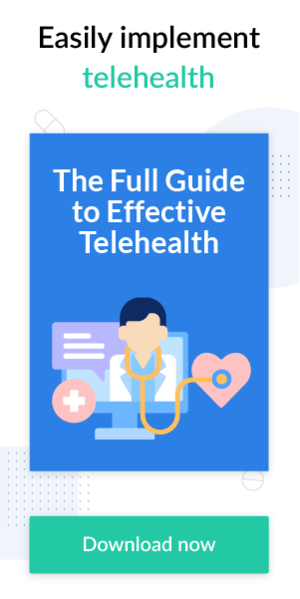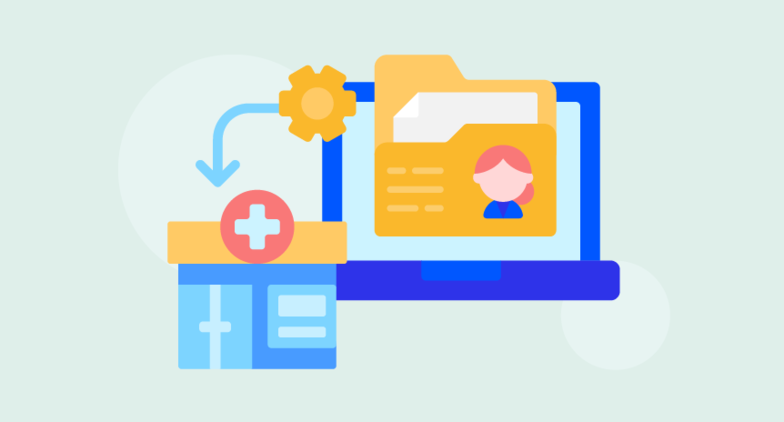The Health Information Technology for Economic and Clinical Health (HITECH) Act became law in 2009, promoting and encouraging the adoption and widespread use of health technology, including electronic health records (EHRs). Switching from paper-based to digital medical records aimed to make patient care higher quality, quicker, and more effective. Paper-based records can’t ensure proper healthcare data security and may lead to medical errors. Moreover, paper-based records:
- require a lot of storage space
- lack medical data backups
However, not all healthcare providers understand the benefits of using electronic health records or what criteria to rely on when choosing secure EHR software.
In this article, we share the key pros and cons of using electronic medical records so it will be easier for you to incorporate EHRs in your clinic and select the right technology stack.
Pros of electronic health records
EHRs can improve the effectiveness of patient care, reduce manual errors, automate clinical operations, and ease physicians’ workloads. However, any automated system has its pros and cons. Let’s start by defining how your healthcare facility and patients can benefit from electronic health records.
#1 Improved diagnostics and patient outcomes
To address a patient’s health needs, physicians need access to a sufficient amount of healthcare data and the ability to constantly work with healthcare professionals from other disciplines.
Electronic health records streamline multidisciplinary communication and provide authorized physicians and medical staff access to accurate patient data and medical histories. This results in:
- faster diagnoses
- more precise treatment decisions
- improved patient health outcomes
- increased satisfaction with the quality of medical services
In contrast, handwritten documents and manual data entry increase the risk of clinical errors, potentially leading to inaccurate diagnoses and incorrect interpretations of a patient’s health conditions. Electronic medical record keeping helps prevent clinical mistakes and improves the effectiveness of patient care through:
- accurate documentation
- secure data storage
- automated notifications and alerts
- easier data analysis
#2 Streamlined medical practice management
EHRs can also improve the organizational efficiency of physicians and medical personnel, eliminating the need to spend countless hours dealing with paperwork, handwriting documents, and manually locating and documenting paper charts with patient data. Instead, an authorized healthcare specialist can easily access digital records at any time.
EHRs also facilitate communication between healthcare providers, letting them share patient information across medical teams, pharmacies, or other healthcare facilities to discuss and coordinate patient treatment in real time.
#3 Increased medical team productivity
EHR systems support automated alerts sent to healthcare providers and patients about upcoming appointments, which can improve patient attendance and increase revenue. You and your medical staff will no longer need to manually remind patients about scheduled checkups or medical procedures, improving time management and boosting productivity.
#4 Improved patient engagement
A tangible benefit of using EHR software is greater patient engagement and education. Having a patient portal as part of your EHR system can help physicians communicate effectively with patients between appointments and involve them in shared healthcare decision-making. For example, after a patient visit, you can use a patient portal to provide:
- an after-visit medical summary
- links to educational literature
- alerts for upcoming checkups
Patients can easily log in to their accounts, see their list of appointments and prescriptions, change appointment details, request lab results, ask healthcare providers questions, and do much more.
#5 Saved office space and resources
EHRs save office space and reduce resource consumption, including for paper, large folders, ink, and file cabinets. With EHRs, internal documents and patient records are kept in one secure digital space and backed up on a remote server that can be easily retrieved in case of data loss.
#6 Improved patient data security
EHRs can ensure adequate data security and safer patient care. You must choose HIPAA-compliant EHR software to meet data security standards and protect healthcare data from unauthorized access and disclosure.
HIPAA security requirements cover all aspects of health data management, from regular health data backups to secure data storage and documentation.

Pro tip: Using all-in-one clinic management software like ExpertBox, you can safeguard the integrity of patient health data and comply with HIPAA requirements.
#7 Improved coding and billing
With an advanced EHR system, physicians can accurately document and maintain medical data records, simplifying billing operations and coding.
This technique allows clinical billers and coders to get information from the EHR system to submit any reimbursement requests for insurance companies and ensure a proper record of medical affairs.
EHR software can also support hospitals with coding and reduce coding errors. There is a different code for each healthcare procedure, and existing codes can change while new codes can be added. Furthermore, insurance providers may have their own codes. An advanced EHR system can record numerous insurance companies’ valid codes for every medical procedure. Your billing and coding teams can see the most up-to-date information, find the correct codes, and leave notes while processing claims or issuing payments.
#8 Customization
Some EHR providers enable users to customize an EHR system according to their specific discipline’s needs. EHR customization makes care more patient-centered and improves system usability, physicians’ workflows, and the patient experience.
For example, a cardiologist may need a different set of data input fields than a dermatologist in order to store patient files or leave notes. The ability to create custom data fields for a specific type of medical practice can significantly simplify a healthcare provider’s workflow and patient management.
Cons of electronic health records
Before you start to deploy your EHR system, you should understand potential pitfalls of implementing EHR software, such as privacy, security, and financial concerns. :
#1 High implementation and maintenance costs
The use of EHRs can be associated with financial obstacles, such as:
- high upfront costs
- expensive technology implementation
- routine technology maintenance
- education, support, and training for medical staff
Transitioning from paper-based to electronic health record-keeping can take time and money. You need to invest in staff training, setting up technology, regular system maintenance, and upgrades.
To prevent data loss and maintain medical data security, EHR technology must be regularly updated and replaced when systems are outdated.
According to a study on the Benefits and drawbacks of electronic health record systems of 14 solo or small-group primary care practices, estimated ongoing EHR maintenance costs averaged $8,412 per provider per year. 91% of these expenses were related to hardware replacement, vendor software maintenance and support fees, and costs for information systems staff or external contractors.

#2 Cybersecurity risks
No modern automated system is immune to cyberattacks. Patient data remains a target for online hackers, as it contains sensitive data such as phone numbers and addresses. This data can be hacked and used by cybercriminals to make purchases or apply for loans.
With the rise of telemedicine and electronic health records, the security of health-related data is crucial. Take a look at 7 cybersecurity tips for healthcare providers to reduce cybersecurity risks and protect the privacy of sensitive data.
#3 Malpractice liability risks
Medical liability claims can go up as EHRs become more widely implemented.
Physicians without sufficient training in EHR technology risk making mistakes, such as inputting inaccurate data in patients’ electronic records, which can harm patient health by leading to incorrect prescriptions or diagnoses.
A 2017 report by The Doctors Company, a medical malpractice insurer, revealed that the number of medical malpractice claims involving EHRs in some way among their approximately 80,000 plan members has risen along with EHR adoption.
Medical liability claims can also come from technology. Although a physician may be well-trained and use software properly, a virus or a malicious program can invade the system if it is insecure or not updated.
#4 Productivity loss
Adopting EHR systems requires time and energy, so a hospital or practice should prepare for reduced productivity and a revenue decline while employees learn how to use the system.
Study on the Benefits and drawbacks of electronic health record systems that involved several clinics estimated a productivity loss of 20% in the first month, 10% in the second month, and 5% in the third month after implementing an EHR system.
Wrapping up
The cons of EHR systems won’t pose a high risk to your business if you adopt modern, HIPAA-compliant technology.
With timely technology updates, meaningful use of electronic health records, and well-trained staff, digital medical records will provide tangible benefits to physicians, healthcare facilities, and patients. Correctly using EHRs can result in an improved quality of patient care, effective discussions among medical teams, reduced healthcare costs, and other benefits.
However, transitioning to electronic health record software requires consistency, an in-depth evaluation of your facility’s readiness and current workflows, and the adoption of new hardware and software.
Take a look at this guide to learn more about the key EHR integration steps to make digital medical records an integral part of your healthcare facility.
FAQ
-
While an electronic medical record includes a patient’s healthcare and treatment history, an EHR system goes beyond medical data collection and provides a comprehensive view of a patient. EHRs include a patient’s current and past medical records, diagnoses, prescriptions, care plans, vaccinations, allergies, X-rays, and lab results.
-
Here’s how your healthcare facility and patients can benefit from electronic medical records:
- Improved diagnostics and patient outcomes
- Streamlined medical practice management
- Increased medical team productivity
- Improved patient engagement
- Saved office space and resources
- Improved patient data security
- Improved coding and billing
- Customization
-
Before you start to deploy your EHR system, you should understand potential pitfalls associated with implementing EHR software, such as privacy, security, and financial concerns. Potential pitfalls may include:
- high implementation and maintenance costs
- cybersecurity risks
- malpractice liability risks
- productivity losses



